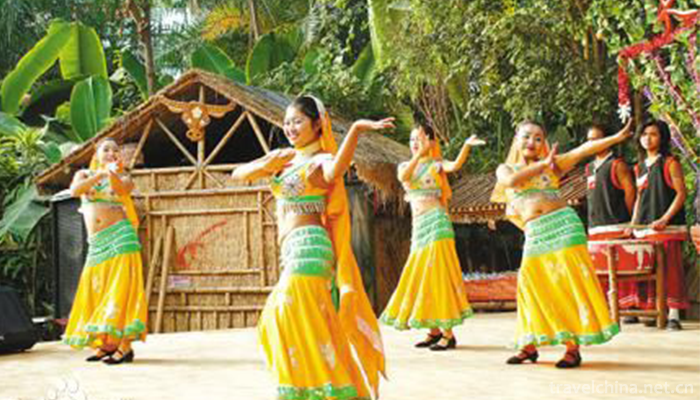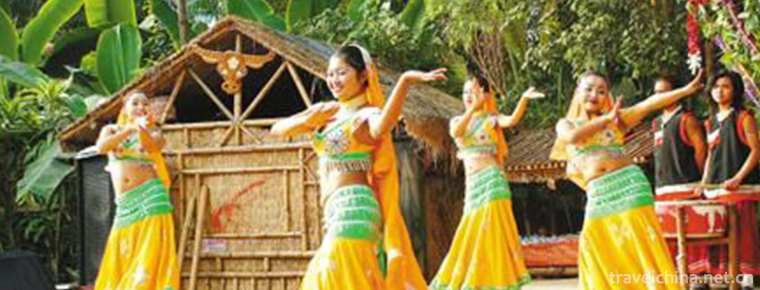Qing Opera of Wa Nationality
Qing Opera of Wa Nationality
The Wa Qing Opera belongs to the high-pitched system, with different roles for men and women. The roles are similar to those of Sheng, Dan, Jing and Wei. Use a dye called "Red Drug" to colour the face and show the person's identity.
Qing Opera of Wa Nationality is one of the representative excellent national literature and art in Tengchong County. It was selected into the second batch of national intangible cultural heritage list in 2008.
On June 7, 2008, the Wa Qing Opera was approved by the State Council to be included in the third batch of national intangible cultural heritage list.
A Brief History of Plays
The Sugarcane Village in Lotus Township, Tengchong County, is famous for its miraculous preservation and transmission of an ancient minority precious opera, Wa Qing Opera.
As early as the late Ming and early Qing Dynasties, the people of Hubei originated from the ancient Qingyang Opera and created a new kind of opera, called Qing Opera, also known as Hubei Gaoqiang Opera. It was once spread in Xiangyang, Jingzhou, Huanggang and other places, and became a very influential local opera. The Ming Dynasty was a time when Tengchong society had undergone tremendous changes and Han culture had become the mainstream in the border areas. Advanced Chinese culture, like fresh blood, flows to the border along the vessel of the ancient road, making learning Chinese culture a fashion and Tengchong a well-known etiquette country in the border areas. After the Qing Dynasty, Tengchong entered an unprecedented period of economic and cultural prosperity. A large number of people flow, logistics, capital flow and cultural flow converged in Tengchong and extended to Myanmar. The internal and external economic and cultural exchanges with Tengchong as the hub became increasingly frequent. Sugarcane stockade is located in the main road of the ancient road. With its superior natural conditions and appropriate geographical location, it has become a post station for business, horse gangs and military on the ancient road from Tengyue to Myanmar. With the increasing number of residents, shops of all sizes have been built on both sides of the old road in the village. Until the 1950s, there were 11 horse shops, hotels, catering and grocery stores operating normally, the largest of which could even accommodate hundreds of mules and horses. At the same time, sugarcane villages have also sprung up the trend of running schools. In the Wa ethnic group, a generation of village literati with Chinese cultural knowledge and devotion to the Han culture has been trained. In the past, among the merchants, soldiers and civilians, sugarcane villages have also brought the refined and popular culture of the mainland. Among them, there are opera artists familiar with Qing opera. In this way, Qing opera has spread in sugarcane villages and gradually evolved into the Wa ethnic Qing Dynasty. Drama.
According to experts'textual research, the time when Qing Opera was introduced into Sugarcane Village was about the period of Xianfeng in Qing Dynasty or before. During the Tongzhi period of the Qing Dynasty, Li Rukai, the head of the Wa ethnic group in Sugarcane Village, advocated to carry forward and actively organize rehearsals and personally play roles, so that Qing Opera could be performed in villages and in surrounding Han villages. This is the flourishing period of the Wa people's Qing Opera, which trained a number of key artists. Thereafter, the times went up and down. In the early period of liberation, when the provincial and local cultural departments conducted a general survey of folk operas, special investigation records were made. From 1958 to 1964, there were several performances. In 1984, the county cultural department excavated and sorted out the Qing Opera, trained actors, participated in County literary and artistic performances, and participated in Regional Literary and artistic performances in the same year, which was praised as "precious national drama". Experts from the Chinese Academy of Traditional Opera also went deep into Sugarcane Village to record and record Wa Qing Opera and formally included it in one of the Chinese minority operas.
In the past, the Wa people's Qing Opera toured villages and villages during the Spring Festival. When it was prosperous, hundreds of "lamp friends" (actors) could be performed. After the 1920s, it gradually declined to extinction. In 1984, after half a century of silence, Dong Qing Opera finally came back to the fore, and at one fell swoop onto the elegant hall of Yunnan farmers'literary and artistic performance, which attracted the keen attention of theatrical circles both inside and outside the province. This experience of "withered trees in spring" may be in line with a lyric of the Wa people's Qing Opera:
A Tianhe River has nine bays.
Nine beaches in front of nine bays.
It is indeed a miracle that the Wa people's Qing Opera can survive.
Performing Characteristics
During the performance, there are roles on the stage, behind the scenes there are helpful voices, and the band has a certain scale. Sugarcane Village has handed down dramas such as "Jiang Gudiao Sister-in-law", "Lulin Meet", "An'an Sends Rice" and "Crossing the Wall into Immortals" with dozens of discounts. Its voice cavity includes Han, Siping, Gaoqiang, opening, crying and Qingjiang Yin, Xiashanhu, Xiaotaohong, Liuyeqing, crying Acacia and so on.
The reason why Wa Qing Opera is called Qing Opera is mainly because "Qing Opera" is that people often read introductions or poems before singing or preaching. Without complicated stature, the performance on stage is based on the actor's understanding of the plot. When singing, small gongs and hairpins are accompanied, and "clanks, clanks, clanks and clanks are used in every sentence or paragraph..." Such gongs and cymbals are separated to set off the rhythmic atmosphere. Big drums, cymbals, gongs and so on are later added to show rough and vigorous. Local artists generally call the martial arts arena "fighting family affairs", and the literary arena "sawing strings". Characters can be divided into life, dan, end and ugliness. In the 1980s, no makeup was used in ancient times. Characters began to wear different kinds of makeup. They wore different clothes, such as split clothes, pleats, pythons, leaners, headwear helmet, crown, towel, hat, beard, boots, masks, etc. They did not pay much attention to the fashion, mostly pasted some simple patterns of birds and animals with paper cuttings on ordinary cloth.
Traditional drama
Nowadays, the common performances of Wa Qing Opera are "Jiang Gudiao's sister-in-law", "chase Pang's family", "Lulin Meeting", "An'an Send Mi", "Hui Dynasty's Purpose", "Jiafeng Han Yu", "Wenlong Ci Wife", "Zhong Li Diao Hua", "Over the Wall into Immortal", "Xiangzi Du Wife" and so on. These performances are based on Han folk stories "Three Filial Pieties" and "Baihe Biography". The voice cavity has "nine chambers and thirteen boards". The nine chambers are Dahan, Siping, Gaoqiang, Fangqiang, crying, Huayin, Baizhen, Canghu and Tuzi. Thirteen boards are Qingjiang Yin, Lang Taosha, Shanpo Goat, Xiashan Tiger, a flower, dripping gold, step Jiao, Zhuyunfei, Xiaotaohong, inverted curtain, cauliflower yellow, willow leaf green, crying Acacia. When these tunes are sung, the tunes are interlaced and transformed, with a group of singers, melodious, melodious, narrative and lyric, with strong expressive force. The drama of the Wa people's Qing Opera has moving stories, vivid plots, beautiful words and distinct characters.
Inheritance Significance
The singing tune of the Wa Qing Opera has remained basically unchanged until now. It still retains its original ecological form when it was introduced into China. It is a precious intangible cultural heritage of ethnic minorities. In recent years, Tengchong County has done a lot of investigation, excavation and collation work on the Wa people's Qing Opera, and obtained the corresponding results. While collecting, sorting out and researching, we actively strive for funds and equipment from relevant departments at higher levels, and support Sugarcane Village and Wa Qing Opera Performance Team to do a good job of inheritance, which has achieved good results. Since 2004, in the national folk traditional culture census, the County Cultural Museum has conducted a comprehensive and in-depth investigation of the Wa ethnic Qing opera, forming systematic text, pictures and image data. After Tengchong County's active declaration and provincial and municipal support and reporting, in June 2008, the Wa Qing Opera was released by the State Council as the second batch of national intangible cultural heritage list. In June 2009, Li Jiaxian was announced by the State Council as the representative successor of the third batch of national intangible cultural heritage projects.


-
1.Big and Small Size Dongtian Scenic Spot
The Size Dongtian Scenic Area (formerly known as the Haishan Scenic Spot and Aoshan Scenic Spot) is located in the southern corner of Nanshan Province, 40 kilometers west of Sanya City
Time 2018-12-12 -
2.Tourist Hall of Shanghai Global Financial Center
Shanghai Global Financial Center is located at 100 Century Avenue, Pudong New Area, Shanghai. It is a skyscraper located in Lujiazui Financial and Trade Zone. It faces the hinterland of Pudong New Are
Time 2018-12-19 -
3.Linhai Qishi Scenic Area
Linhai Qishi Scenic Area is located in Tangwanghe District, Yichun City, Heilongjiang Province. Scenic area covers 190 square kilometers. It is a new eco-tourism area and National Geological Heritage
Time 2019-01-30 -
4.Daur Costume
The Daur nationality has a long history and agricultural culture in northern China. Daur garments are greatly influenced by Mongolian and Manchu nationalities.
Time 2019-04-22 -
5.Firing Techniques of Guangcai Porcelain
Guangcai Porcelain Firing Technology, a local traditional handicraft in Guangzhou, Guangdong Province, is one of the national intangible cultural heritages.
Time 2019-05-01 -
6.Construction Techniques of Hakka Tulou
Hakka Tulou building construction technology, Fujian Longyan City Nanjing County, Huaan County local traditional building construction technology, one of the national intangible cultural heritage.
Time 2019-05-09 -
7.Luochuans drums
Luochuan Yigu, a traditional dance in Luochuan County, Shaanxi Province, is one of the national intangible cultural heritage.
Time 2019-05-15 -
8.Uygur moulding earthenware firing
Uygur moulding pottery has a history of more than two thousand years. After the middle of the ninth century, Uygur ancestors moved westward to the vicinity of the Tarim Basin, inherited the pottery ma
Time 2019-06-26 -
9.Xie Rong Zhongzi
Xierong Zhongzi still keeps the primitive and simple legacy, from which we can see the spiritual sustenance and aesthetic pursuit of Tibetan ancestors. This kind of primitive culture and art has becom
Time 2019-07-06 -
10.How long does it take for Chengdu to get to the giant panda base
When you come to Chengdu, you must come and see the lovely giant panda. The nearest panda base to the city is the giant panda breeding research base. How long does it take from Chengdu to the giant panda base?
Time 2020-12-13 -
11.Luzhou natural resources
The total amount of water resources in Luzhou is 6.657 billion cubic meters per year. The groundwater reserves are rich, reaching 1.065 billion cubic meters per year, among which Xuyong and Gulin counties in the south are the richest. The structural fissure water in the south
Time 2020-12-14 -
12.Hydrology of Neijiang River
Tuojiang River is the main river in the urban area. It flows through Zizhong, Dongxing and Shizhong District. It is the main waterway transportation route in the city. Since ancient times, there has been a busy scene description of "boats of ten thousand trees
Time 2020-12-16